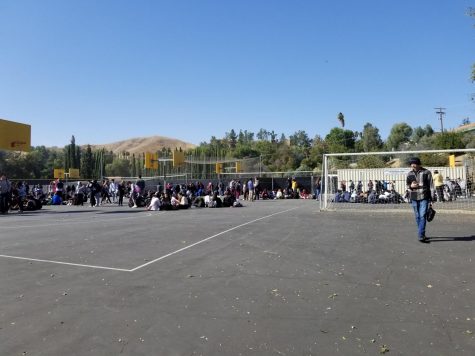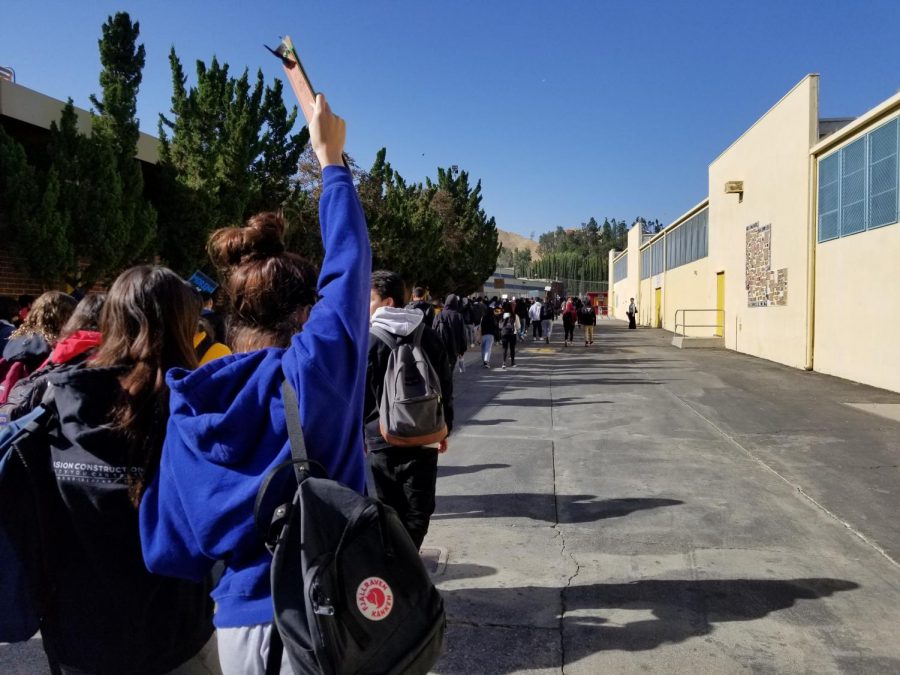Marching towards safety.
The Great Shake Drill
November 4, 2019
On October 30, 2019, millions of people worldwide practice how to “Drop, Cover, and Hold-on” during the Great Shakeout Earthquake Drills. This drill started in 2009, and this year is the 12th year that it is happening. Almost all school districts are participating in this drill to teach and educate students about the importance of knowing how to take care of yourself.
This drill is an excellent opportunity for families to learn how to prepare and survive in case of an earthquake. In 2018, 10.3 million people participated in this drill, and this year there are 10.8 million and counting (shakeout.org).
As we all know, an earthquake can be as little as not to be felt at all or can be as destructive as damaging buildings. This is why Taft has provided students with a step by step guide that will ensure their safety and survival.
There are three steps that people need to follow. Drop, cover, and hold-on. Every step is crucial, and it is essential to be able to survive an earthquake. They can save your life and reduce the risk of injury. Let’s go over the steps:
1. Wherever you are, drop onto your hands and knees. This will prevent you from getting knocked down and can help you easily crawl to different locations if needed.
2. Cover your head and neck with your arms. If there happens to be a sturdy table nearby, crawl underneath for shelter. If there are no tables close, go near a wall with no windows. Under no circumstances should a student go near windows or objects that might fall, such as cabinets, wardrobes, bookshelves.
3. Hold on until the shaking stops and stay in place until you know that you are safe.
Although scenarios may vary, depending on different factors, we will assume a powerful earthquake is taking place. One being 5.5 or higher magnitude in the Richter scale, which is capable of causing structural damage, according to Geo.mtu.ed’s Website.
After the shaking stops, a student must remain undercover, for another aftershock might occur. In the meantime, students will be given directions from their teachers and the school’s headmaster, such as the principal, on what to do next.
If the earthquake occurs at lunch or nutrition, students are to go to the previous classroom they were in. For example, if this happens during nutrition, you would go to your second period. If it occurs during lunch, you are to go to your fourth period. We do this because attendance has already been taken for who is present, and they know who to search for in case someone is lost. When the educator in charge decides that it is alright for the class to search for a safer location, they will inform everyone and calmly head for an open area. Some secure areas for Taft High School are the basketball courts, baseball field, and football field.
Next, preparing for aftershocks, which could occur in a matter of minutes. You should not head home until authorities indicate it is safe to do so. You must check for injuries and hazards provoked by the earthquake. Falling debris, fires, broken glass, unstable energy lines, and furniture are to be avoided.

Students are placed in a safe, controlled environment to avoid any risk.
There are two reunion points at Taft: the two gates around E building leading to the student parking lot and the main entrance. It is recommended to not drive during or after an earthquake occurs. Students are to be picked up only by authorized family members and relatives. If you are a senior, you will (ONLY if you possess a vehicle) be dismissed after a certain period after the earthquake.
The drill was great. All the students participated and were behaving in an orderly fashion. Each class had its spot on the black-top, and the drill went through 3rd and half of 4th period.

Torrie Jackson • Nov 22, 2019 at 5:38 pm
I feel like this article spoke to me because this is the one time you see the whole school come together even though it might not be for a good situation its the only time you see everybody together all races and people that go to school together some people play basketball with people they met our never even thought went to this school ,some people come together to play football all around its a way for people to all be together.
Jared B • Nov 7, 2019 at 3:56 pm
this is very cool. it shook ( I’m sorry) to my core (I promise I will stop) that these seemingly useless drills have a purpose and that they can give a great magnitude (I lied) of information.